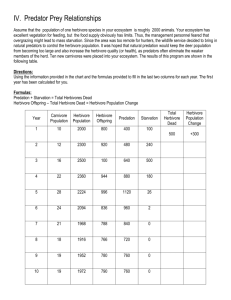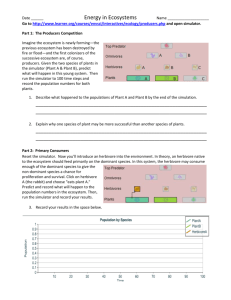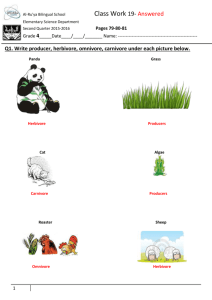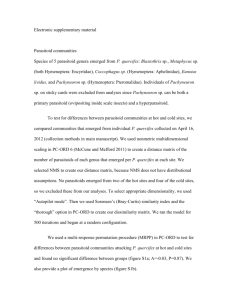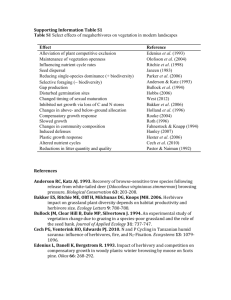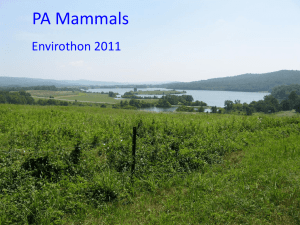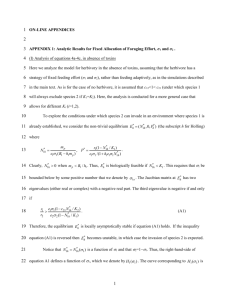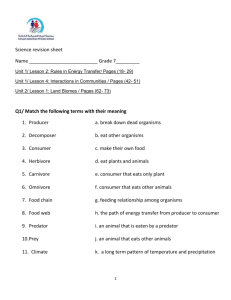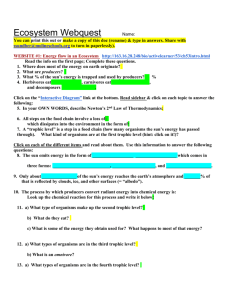Appendix 1. Feeding guild classification of invertebrate families
advertisement
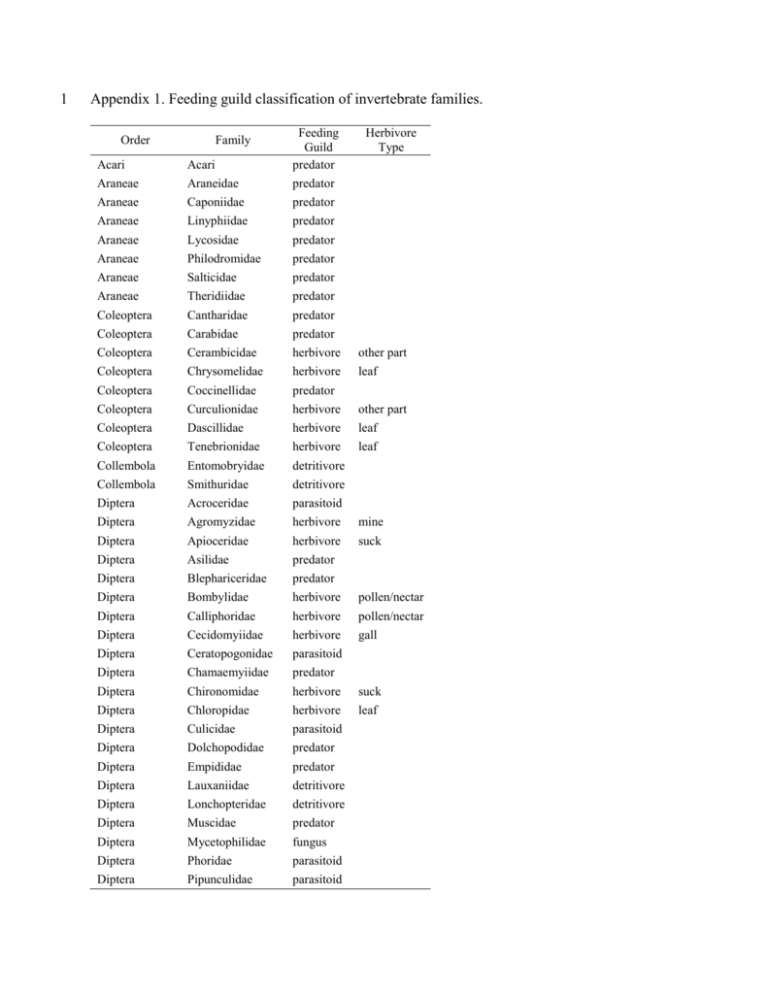
1 Appendix 1. Feeding guild classification of invertebrate families. Acari Acari Feeding Guild predator Araneae Araneidae predator Araneae Caponiidae predator Araneae Linyphiidae predator Araneae Lycosidae predator Araneae Philodromidae predator Araneae Salticidae predator Araneae Theridiidae predator Coleoptera Cantharidae predator Coleoptera Carabidae predator Coleoptera Cerambicidae herbivore other part Coleoptera Chrysomelidae herbivore leaf Coleoptera Coccinellidae predator Coleoptera Curculionidae herbivore other part Coleoptera Dascillidae herbivore leaf Coleoptera Tenebrionidae herbivore leaf Collembola Entomobryidae detritivore Collembola Smithuridae detritivore Diptera Acroceridae parasitoid Diptera Agromyzidae herbivore mine Diptera Apioceridae herbivore suck Diptera Asilidae predator Diptera Blephariceridae predator Diptera Bombylidae herbivore pollen/nectar Diptera Calliphoridae herbivore pollen/nectar Diptera Cecidomyiidae herbivore gall Diptera Ceratopogonidae parasitoid Diptera Chamaemyiidae predator Diptera Chironomidae herbivore suck Diptera Chloropidae herbivore leaf Diptera Culicidae parasitoid Diptera Dolchopodidae predator Diptera Empididae predator Diptera Lauxaniidae detritivore Diptera Lonchopteridae detritivore Diptera Muscidae predator Diptera Mycetophilidae fungus Diptera Phoridae parasitoid Diptera Pipunculidae parasitoid Order Family Herbivore Type Diptera Platypezidae fungus Diptera Sarcophagidae detritivore Diptera Scatopsidae detritivore Diptera Sciaridae detritivore Diptera Sepsidae detritivore Diptera Simulidae parasitoid Diptera Stratiomyidae detritivore Diptera Tachinidae parasitoid Diptera Tephritidae herbivore other part Diptera Tipulidae herbivore pollen/nectar Ephemeroptera unk none Hemiptera Acanaloniidae herbivore suck Hemiptera Alydidae herbivore suck Hemiptera Aphididae herbivore suck Hemiptera Berytidae herbivore suck Hemiptera Cicadellidae herbivore suck Hemiptera Cicadidae herbivore suck Hemiptera Coreidae herbivore suck Hemiptera Corimelaenidae herbivore suck Hemiptera Dictyopharidae herbivore suck Hemiptera Hetroptera nymph herbivore suck Hemiptera Lygaeidae herbivore suck Hemiptera Membracidae herbivore suck Hemiptera Miridae herbivore suck Hemiptera Pentatomidae herbivore suck Hemiptera Reduviidae predator Hemiptera Tingidae herbivore suck Hymenoptera Apidae herbivore pollen/nectar Hymenoptera Braconidae parasitoid Hymenoptera Cynipidae parasitoid Hymenoptera Diapriindae parasitoid Hymenoptera Dryinidae parasitoid Hymenoptera Eulophidae parasitoid Hymenoptera Eupelmidae parasitoid Hymenoptera Eurytomidae herbivore Hymenoptera Formicidae predator Hymenoptera Halticidae herbivore Hymenoptera Ichneumonidae parasitoid Hymenoptera Mymaridae parasitoid Hymenoptera Proctotrupidae parasitoid Hymenoptera Pteromalidae parasitoid Hymenoptera Scelionidae parasitoid Hymenoptera Tiphidae parasitoid leaf pollen/nectar 2 Hymenoptera Torymidae parasitoid Hymenoptera Vespidae predator Isoptera Termitidae herbivore other part Lepidoptera Crambidae herbivore suck Lepidoptera Hesperiidae herbivore suck Lepidoptera larvae herbivore leaf Lepidoptera Noctuidae herbivore suck Lepidoptera Pterophoridae herbivore suck Lepidoptera Tortricidae herbivore suck Lepidoptera unk herbivore suck Neuroptera Hemerobiidae predator Orthoptera Acrididae herbivore leaf Orthoptera Gryllidae herbivore leaf Orthoptera Tettigonidae herbivore leaf Phasmatodea Heteronemiidae herbivore leaf Plecoptera Plecoptera herbivore other part Psocoptera unk detritivore Thysanoptera Phloeothripidae herbivore leaf Thysanoptera Thripidae herbivore leaf 3 Appendix 2. Community composition of invertebrate herbivores varies through space and time. 4 Shown are pseudo f-values from a PERMANOVA examining variation in the composition of 5 invertebrate feeding guilds (leaf chewing herbivores, gall-forming herbivores, sap-sucking 6 herbivores, leaf mining herbivores, pollen/nectar eating herbivores, detritivores, fungivores, 7 predators, parasitoids) across three sites spanning the U.S. Central Great Plains (site) and through 8 time (year). Degrees of freedom are shown in parentheses. Bold text indicates a significant effect 9 (p<0.05). site year site*year 10 feeding guild 3.99(1,32) 2.87(1,32) 3.17(1,32) 11 Appendix 3. Specific invertebrate functional groups vary through space and time, while others 12 remain relatively constant. Results from an analysis of variance (ANOVA) examining variation 13 in the composition of invertebrate herbivores (leaf chewers, gall formers, sap suckers, and other 14 herbivores), fungivores, detritivores, and secondary consumer (parasitoids and predators) feeding 15 guilds across three sites spanning the U.S. Central Great Plains (site) and through time (year). 16 Shown are f-values and degrees of freedom (in parentheses). Bold text indicates a significant 17 effect (p<0.05). site year site*year Leaf Chewers 8.64(2,18) 4.28(2,18) 1.61(4,18) Gall Formers 0.78(2,18) 2.84(2,18) 0.35(4,18) Sap Suckers 44.02(2,18) 26.37(2,18) 29.07(4,18) Other Herbivores 1.62(2,18) 3.00(2,18) 0.81(4,18) 18 Fungivores Detritivores 2.00(2,18) 0.84(2,18) 0.50(2,18) 0.84(2,18) 0.50(4,18) 1.08(4,18) Parasitoid Predator 2.05(2,18) 0.76(2,18) 5.36(2,18) 1.13(2,18) 2.65(4,18) 2.57(4,18) 19 Appendix 4. Soil nutrient additions directly alter plant biomass and tissue chemistry, and 20 indirectly alter herbivore abundances and feeding rates at three grassland sites. F-values from 21 analyses of variance (ANOVAs) examining the effects of nutrient additions (N=nitrogen, 22 P=phosphorus, K=potassium plus micronutrients) on aboveground plant biomass, community 23 aggregate leaf % Nitrogen, the number of invertebrate leaf chewing herbivores, the per capita 24 rate of herbivory, and the total amount of leaf tissue removed by leaf chewing herbivores at three 25 sites spanning the US Central Great Plains (TGP=tallgrass prairie, MIX=mixed grass prairie, 26 SGS=shortgrass steppe). Degrees of freedom are shown in parentheses. Bold text indicates a 27 significant effect (p<0.05). Aboveground Community Leaf Per Capita Plant Aggregate Chewing Rate of Biomass Leaf % N Herbivores Herbivory TGP N P K N*P N*K P*K N*P*K MIX N P K N*P N*K P*K N*P*K SGS N P K N*P N*K P*K N*P*K Total Leaf Tissue Removed 15.59(1,16) 2.39(1,16) 0.86(1,16) 8.09(1,16) 0.80(1,16) 1.47(1,16) 1.92(1,16) 11.47(1,16) 0.62(1,16) 0.33(1,16) 0.07(1,16) 0.22(1,16) 0.82(1,16) 0.28(1,16) 26.23(1,16) 0.06(1,16) 0.00(1,16) 0.69(1,16) 0.42(1,16) 0.06(1,16) 0.01(1,16) 7.50(1,16) 0.21(1,16) 0.00(1,16) 3.48(1,16) 2.40(1,16) 0.41(1,16) 2.38(1,16) 0.67(1,16) 0.13(1,16) 0.45(1,16) 1.44(1,16) 1.76(1,16) 0.06(1,16) 2.02(1,16) 1.78(1,16) 18.92(1,16) 0.01(1,16) 0.06(1,16) 2.98(1,16) 1.14(1,16) 0.09(1,16) 2.31(1,16) 0.45(1,16) 1.58(1,16) 0.01(1,16) 1.20(1,16) 0.37(1,16) 0.36(1,16) 1.84(1,16) 2.06(1,16) 0.44(1,16) 0.00(1,16) 0.17(1,16) 0.19(1,16) 0.01(1,16) 1.03(1,16) 0.54(1,16) 0.00(1,16) 0.02(1,16) 0.00(1,16) 0.89(1,16) 0.63(1,16) 0.12(1,16) 0.21(1,16) 0.07(1,16) 0.17(1,16) 0.28(1,16) 0.12(1,16) 0.49(1,16) 1.05(1,16) 1.03(1,16) 0.04(1,16) 0.01(1,16) 1.25(1,16) 0.00(1,16) 1.33(1,16) 59.24(1,16) 0.61(1,16) 0.02(1,16) 0.85(1,16) 1.22(1,16) 0.08(1,16) 2.88(1,16) 2.37(1,16) 0.67(1,16) 0.05(1,16) 0.09(1,16) 0.25(1,16) 0.29(1,16) 0.14(1,16) 12.97(1,16) 13.83(1,16) 6.15(1,16) 9.67(1,16) 0.34(1,16) 0.70(1,16) 2.19(1,16) 3.01(1,16) 0.15(1,16) 0.13(1,16) 1.09(1,16) 1.51(1,16) 0.14(1,16) 0.18(1,16) 28 Appendix 5. Soil nutrient additions do not affect invertebrate effects on aboveground plant 29 biomass at three grassland sites. Results from analyses of variance (ANOVAs) examining the 30 effects of removing invertebrate herbivores (remove) nested within nutrient addition treatments 31 (nutrient) on aboveground biomass at three sites spanning the US Central Great Plains 32 (TGP=tallgrass prairie, MIX=mixed grass prairie, SGS=shortgrass steppe). Shown are f-values 33 and degrees of freedom (in parentheses). Bold text indicates a significant effect (p≤0.05). model SGS MIX TGP 0.98(15,47) 1.94(15,47) 3.10(15,47) remove 2.42(1) nutrient 1.23(7) remove(nutrient) 0.53(7) 34 6.97(1) 2.69(7) 0.47(7) 5.85(1) 4.90(7) 0.91(7) 35 36 Appendix 6. Invertebrate herbivore communities naturally vary through space and time in 37 grasslands. Multidimensional scaling plot of natural variation in invertebrate feeding guild 38 composition (i.e., control plots only) at three sites (SGS=shortgrass steppe; MIX=mixed-grass 39 prairie; TGP=tallgrass prairie) over three years (2009-2011).
